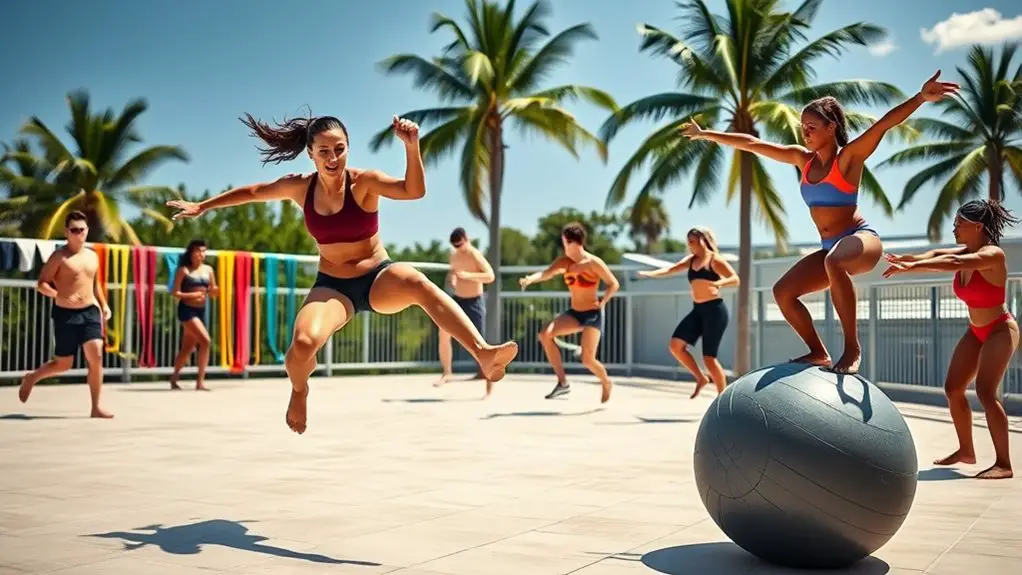To build forearm strength for rock climbing, focus on exercises like wrist rollers, fingerboard training, and farmers walks. Incorporating a variety of grips—such as pinch and crimp—will boost your grip endurance. Use hangboards for specific grip training and include pull-ups in your routine for overall strength. Don't forget to warm up properly and track your progress to stay motivated. Keep going, and you'll discover more techniques to enhance your climbing performance.
Understanding the Importance of Forearm Strength in Climbing
While many climbers focus on overall strength and technique, understanding the importance of forearm strength is essential for improving your performance on the wall. Your forearms play a vital role in gripping holds and maintaining control during climbs. If your forearm strength lags, you might find yourself struggling on overhangs or feeling fatigued too soon.
Building this strength isn't just about muscle; it's about releasing your potential for freedom in movement. Strong forearms enable you to hold onto those challenging grips longer, allowing you to explore higher routes and embrace the thrill of climbing. Moreover, grip strength can significantly enhance your endurance, leading to longer, more adventurous climbs without the dreaded pump. By prioritizing forearm workouts, you're not just training; you're empowering yourself to break barriers and chase the exhilarating freedom that climbing offers. So, embrace the journey of building your forearm strength and watch your climbing skills soar.
Anatomy of the Forearm: Key Muscles for Climbers
To maximize your forearm strength, it's important to understand the key muscles at play. Your forearm consists primarily of flexor and extensor muscles, which control gripping and releasing. The flexor group, including the flexor digitorum and flexor pollicis longus, helps you grasp holds tightly, while the extensors, like the extensor digitorum, enable you to open your hand and stabilize your grip.
Another essential muscle is the brachioradialis, which assists in flexing your elbow and contributes to overall arm strength. Developing grip strength not only enhances your climbing performance but also improves overall health and physical fitness, empowering you to embrace a life filled with strength and vigor.
Understanding these muscles allows you to target your training effectively. By focusing on both gripping and releasing motions, you'll build balanced strength that enhances your climbing performance. When you know how these muscles work together, you can train smarter, not harder, setting you free to tackle those challenging routes with confidence. Embrace this knowledge, and let it guide your journey toward climbing mastery.
Essential Equipment for Forearm Training
To build your forearm strength effectively, you'll need some essential equipment. Grip strengtheners, hangboards, and resistance bands are great tools to help you target those key muscles. Let's explore how each of these can enhance your training routine.
Grip Strengtheners
When it comes to building forearm strength for rock climbing, grip strengtheners are essential tools that can make a significant difference. These devices are designed to improve your grip by providing resistance in a controlled manner, allowing you to focus on specific muscles. They come in various forms, like hand grippers and finger strengtheners, making it easy to find one that suits your needs. Incorporating grip strengtheners into your routine can release your climbing potential, giving you the freedom to tackle tougher routes with confidence. Just a few minutes a day can lead to noticeable improvements, helping you feel more connected to the rock. So, grab a grip strengthener and start building that forearm power!
Hangboards and Systems
Grip strengtheners are just the beginning of your forearm training journey. To truly reveal your climbing potential, you'll want to invest in a hangboard. These boards let you hang and train your grip on various holds, mimicking real climbing conditions. Start with a few seconds on different grips, gradually increasing time as you build endurance.
Incorporating systems like campus boards can add variety to your routine, pushing your limits further. You're free to customize your training sessions based on your goals and the holds that challenge you the most. Just remember to listen to your body; recovery is key to avoiding injury. Embrace the grind, and soon enough, you'll feel the power in your forearms while climbing.
Resistance Bands
Resistance bands are a fantastic addition to your forearm training toolkit. They're versatile, lightweight, and easy to use, making them perfect for climbers who want to build strength without being weighed down. You can perform various exercises, like wrist curls and reverse wrist curls, to target different muscle groups in your forearms. Plus, they allow for a full range of motion, which helps develop functional strength essential for climbing.
Simply anchor the band and adjust the resistance to match your level. You can even take them outdoors or on trips, giving you the freedom to train anywhere. Incorporate resistance bands into your routine, and you'll notice improved grip strength and endurance, elevating your climbing game to new heights.
Effective Forearm Exercises for Climbers
When it comes to building forearm strength for climbing, incorporating wrist rollers and fingerboard training can make a big difference. You'll want to master the technique of wrist rollers to effectively target those muscles, while fingerboards offer a great way to improve your grip. Additionally, exercises like Farmers Walk can significantly boost your forearm strength and grip stability, making them essential for climbers. Let's explore how these exercises can enhance your climbing performance.
Wrist Rollers Technique
Although many climbers focus on finger strength, neglecting forearm conditioning can hinder overall performance. One effective way to boost your forearm strength is through wrist rollers. This simple yet powerful tool helps enhance grip and endurance. Here's how to get started:
- Choose the right weight: Start with a manageable weight to avoid strain.
- Position your hands: Hold the handles with your palms facing down.
- Roll it up: Rotate your wrists to wind the rope and lift the weight towards you.
- Roll it down: Reverse the motion slowly to work on eccentric strength.
Incorporating wrist rollers into your routine will not only build forearm strength but also improve your climbing performance, giving you the freedom to conquer those challenging routes.
Fingerboard Training Tips
To maximize your forearm strength for climbing, incorporating fingerboard training into your routine can be highly effective. Start with a solid warm-up to prevent injuries; your fingers need to be ready! Focus on different grip types—open hand, crimp, and pinch—to develop all-around strength. Aim for short, intense sessions, like 7 seconds on and 3 seconds off, repeating for several sets. Don't forget to listen to your body; recovery is key! It's easy to get carried away, but too much can lead to overuse injuries. Incorporate rest days into your training schedule. Finally, consider adding dynamic movements, like pull-ups, to enhance your grip strength. Enjoy the process, and watch your climbing abilities soar as your forearms get stronger!
Incorporating Grip Training Into Your Routine
Incorporating grip training into your routine is essential for enhancing your rock climbing performance, as a strong grip can greatly improve your ability to hold onto challenging holds. To make grip training effective, consider these four key strategies:
- Use a Variety of Grips: Incorporate pinch grips, open hand grips, and crimp grips to build overall grip strength.
- Integrate Dead Hangs: Spend time hanging from a bar or fingerboard. Start with shorter intervals and gradually increase your hang time.
- Add Weighted Pull-Ups: These will not only strengthen your grip but also your upper body, giving you more power on the wall.
- Include Grip Strength Tools: Use grip trainers, stress balls, or even a towel for added resistance in your workouts. Additionally, a strong grip fosters confidence, enabling fearless engagement in climbing.
Utilizing Climbing-Specific Movements
Building grip strength is just one part of the equation; you also need to focus on climbing-specific movements that mimic the challenges you'll face on the wall. Incorporate exercises like pull-ups, dead hangs, and lock-offs into your routine. These not only build forearm strength but also engage your entire upper body, essential for dynamic climbing.
Don't forget about traversing on a climbing wall—it's a fantastic way to develop your technique while building strength. Try varying your handholds and using different grip styles, like pinches and slopers, to target different muscles.
You can also practice foot placements and body positioning to improve your overall climbing efficiency. The more you train in ways that reflect real climbing scenarios, the better prepared you'll be when it's time to tackle your next route. Embrace these movements, and you'll find yourself climbing with newfound freedom and confidence. Additionally, incorporating deadlifts into your training can enhance your overall power and stability, which is crucial for tackling challenging climbs.
The Role of Endurance in Forearm Strength
While many climbers focus solely on grip strength, endurance plays an essential role in developing your forearm strength for extended climbs. Without endurance, your grip will fade, limiting your freedom to explore challenging routes. To boost your forearm endurance, consider the following:
- Hangboard Training: Incorporate longer hangs at lower intensities to build stamina.
- Dynamic Climbing: Engage in longer, flowing routes that require sustained effort and movement.
- Isometric Holds: Practice static holds on various grips to enhance muscular endurance.
- Climbing Circuits: Set up a series of climbs with minimal rest to simulate fatigue and improve endurance. Additionally, focusing on muscular endurance through varied training methods will enhance your overall performance and resilience on the rock.
Tips for Preventing Injury During Training
When you're training to build forearm strength for rock climbing, it's essential to prioritize injury prevention. Incorporating warm-up exercises, progressing your loads gradually, and allowing for adequate rest can make a significant difference. These strategies not only enhance your performance but also keep you safe from potential setbacks. Remember that incorporating rest days is crucial for avoiding burnout and supporting your overall training success.
Warm-Up Exercises Importance
Incorporating warm-up exercises is essential for preventing injuries during your rock climbing training. When you prepare your body, you're not just enhancing performance; you're safeguarding your freedom to climb without setbacks. Here are four key warm-up exercises you shouldn't skip:
- Wrist Circles: Loosen up your wrists to enhance flexibility.
- Finger Stretching: Open up your fingers to prevent strain.
- Dynamic Arm Swings: Increase blood flow to your forearms and shoulders.
- Shoulder Rolls: Release tension and improve mobility.
Gradual Load Progression
After warming up, it's crucial to focus on gradual load progression to build forearm strength safely. Start with manageable weights or resistance that you can control, and don't rush the process. Increase the load only when you feel confident and your muscles adapt to the current challenge. Listen to your body; if something feels off, back off and reassess. Consider tracking your progress to stay motivated and guarantee you're gradually pushing your limits without overdoing it. Incorporate a variety of exercises to target different muscle groups in your forearms, keeping your training balanced and effective. Prioritizing gradual progression is key to enhancing your strength while minimizing injury risks, so you can keep climbing freely and joyfully.
Rest and Recovery Tips
To effectively build forearm strength and prevent injuries, prioritizing rest and recovery is essential. Pushing your limits is thrilling, but neglecting recovery can lead to setbacks. Here are some tips to help you stay strong and injury-free:
- Rest Days: Schedule at least one full rest day per week to let your muscles recover.
- Active Recovery: Engage in low-intensity activities like yoga or light stretching to promote blood flow.
- Hydration: Drink plenty of water before, during, and after training to keep your muscles hydrated.
- Sleep: Aim for 7-9 hours of quality sleep each night to allow your body to repair itself.
Embrace these practices, and you'll enjoy the freedom of climbing without the worry of injury!
Creating a Balanced Training Program
While it might be tempting to focus solely on forearm exercises for rock climbing, creating a balanced training program is crucial for overall performance and injury prevention. Incorporate exercises that target your entire body, as climbing demands strength, flexibility, and endurance from multiple muscle groups. Think about adding core workouts, leg strength training, and mobility drills to your routine.
Don't forget about grip variations, too! Mix in pull-ups, fingerboard training, and wrist curls alongside your forearm workouts. This variety not only helps avoid overuse injuries but also guarantees your muscles work harmoniously. Additionally, incorporating mobility training can enhance your range of motion and reduce injury risk, ultimately benefiting your climbing performance.
Aim for a combination of strength, endurance, and technique-focused sessions throughout the week, allowing for adequate rest. Keep it fun and engaging by experimenting with different activities, like bouldering or yoga, to maintain your motivation. A well-rounded program will empower you to climb stronger and longer, giving you the freedom to explore new heights.
Tracking Your Progress and Set Goals
A balanced training program sets the stage for tracking your progress effectively and setting achievable goals. To enhance your forearm strength and climbing performance, you'll want to keep an eye on your advancements. Here's how to do it:
- Keep a Training Log: Document your workouts, noting exercises and reps.
- Set Specific Goals: Instead of vague objectives, aim for clear targets, like increasing your grip time by 10 seconds.
- Assess Regularly: Test your forearm strength every few weeks to see how you're improving.
- Celebrate Milestones: Acknowledge when you hit your goals; it keeps you motivated and free-spirited!
Tracking your progress not only helps you stay accountable but also allows you to adjust your training as needed. With clear goals in mind, you'll feel more empowered to push your limits and enjoy the journey of becoming a stronger climber.
Frequently Asked Questions
How Long Does It Take to See Forearm Strength Improvements?
You'll start noticing improvements in forearm strength within a few weeks of consistent training. However, everyone's different, so stay patient and keep pushing your limits; those gains will come if you stick with it!
What Should I Eat to Support Forearm Strength Training?
Fuel your journey like a well-tuned engine. To support your forearm strength training, focus on lean proteins, healthy fats, and plenty of fruits and veggies. They'll help you crush your goals and unleash your potential!
Can I Train Forearms Without Climbing Regularly?
Yes, you can absolutely train your forearms without climbing regularly! Incorporate exercises like wrist curls, dead hangs, and grip trainers into your routine. You'll build strength and endurance, keeping your forearms ready for any challenge!
Are There Any Supplements That Help With Forearm Strength?
While there aren't specific supplements for forearm strength, protein, creatine, and BCAAs can support overall muscle growth. Just remember, nothing beats consistent training and hard work for achieving your goals and gaining that freedom.
How Often Should I Train My Forearms Each Week?
Wondering how often you should train your forearms? It's essential to strike a balance. Aim for two to three times a week, allowing rest days to promote recovery and growth, revealing your true potential.




